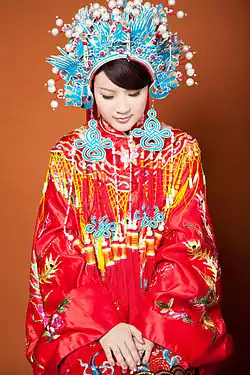
Chinese clothing includes the traditional hanfu and garments of ethnic minorities, as well as modern variations of indigenous Chinese dresses. Chinese clothing has been shaped through its dynastic traditions, as well as through foreign influences.[1] Chinese clothing showcases the traditional fashion sensibilities of Chinese culture traditions and forms one of the major cultural facets of Chinese civilization.[2]
Imperial China

Traditional Han clothing has a recorded history of more than three millennia until the end of the Ming dynasty.[2] Most Chinese men wore Chinese black cotton shoes, but wealthy higher-class people would wear tough black leather shoes for formal occasions. Very rich and wealthy men would wear very bright, beautiful silk shoes, sometimes with leather on the inside. Women would wear silk shoes, often with holes in the top for their feet to fit in, with certain wealthy women practicing foot binding wearing coated lotus shoes as a status symbol until in the early 20th century.
Civil and military officials
Chinese civil or military officials used a variety of codes to show their rank and position. The most recognized is the mandarin square or rank badge. Another way to show social standing and civil rank was the use of colorful hat knobs fixed on the top of their hats. The specific hat knob on one's hat determined one's rank, as there were twelve types of hat knobs representing the nine distinctive ranks of the civil or military position. Variations existed for Ming dynasty official headwear. In the Qing dynasty different patterns of robes represented different ranks.
Qing dynasty (1644–1912)

The rise of the Manchu Qing dynasty in many ways represented a new era in Chinese clothing, with certain styles required to be worn by all noblemen and officials. Eventually, these styles also became widespread among the commoners.[4] Manchu official headwear differed from the Ming version, but the Qing continued to use the Mandarin square.
Republican era

The abolition of imperial China in 1912 had an immediate effect on dress and customs. The largely Han Chinese population immediately cut off their queues they had been forced to grow in submission to the overthrown Qing dynasty. Sun Yat-sen popularised a new style of men's wear, featuring jacket and trousers instead of the robes worn previously. Adapted from Japanese student wear, this style of dress became known as the Zhongshan suit (Zhongshan being one of Sun Yat-sen's given names in Chinese).
For women, a transformation of the traditional qipao resulted in a slender form-fitting dress with a high cut. This new "cheongsam" contrasted sharply with the traditional qipao but has largely replaced it in modern fashion. In the early republican period, the traditional dudou underbodice was largely abandoned in favor of Western-style corsets and bras.
Early People's Republic
Early in the People's Republic, Mao Zedong inspired Chinese fashion with his own variant of the Zhongshan suit, which would be known to the west as Mao suit. Meanwhile, Sun Yat-sen's widow, Soong Ching-ling, popularized the cheongsam as the standard female dress. At the same time, clothing viewed as backwards and unmodern by both the Chinese as well as Westerners, was forbidden.
Around the Destruction of the "Four Olds" period in 1964, almost anything seen as part of traditional Chinese culture would lead to problems with the Communist Red Guards. Items that attracted dangerous attention if caught in the public included jeans, high heels, Western-style coats, ties, jewelry, cheongsams, and long hair.[5] These items were regarded as symbols of bourgeois lifestyle, which represented wealth. Citizens had to avoid them or suffer serious consequences such as torture or beatings by the guards.[5] A number of these items were thrown into the streets to embarrass the citizens.[6]
Modern fashion
Hong Kong clothing brand Shanghai Tang's design concept is inspired by historical Chinese clothing. It set out to rejuvenate Chinese fashion of the 1920s and 30s, in bright colors and with a modern twist.[7][8] Other Chinese luxury brands include NE Tiger,[9] Guo Pei,[10] and Laurence Xu.[11]
In the year 2000, dudou-inspired blouses appeared in the summer collections of Versace and Miu Miu, leading to its adoption within China as a revealing form of outerwear.
For the 2012 Hong Kong Sevens tournament, sportswear brand Kukri Sports teamed up with Hong Kong lifestyle retail store G.O.D. to produce merchandising, which included traditional Chinese jackets and cheongsam-inspired ladies polo shirts.[12][13][14]
In recent years, renewed interest in traditional Chinese culture has led to a movement in China advocating for the revival of hanfu.[15][16][17] As an increasing number of Chinese people like and attach importance to hanfu, hanfu no longer only appears in Chinese drama as in the past.
Gallery
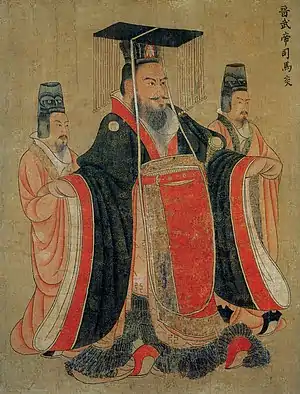 Emperor Wu of Jìn, by Yan Liben (600–673)
Emperor Wu of Jìn, by Yan Liben (600–673)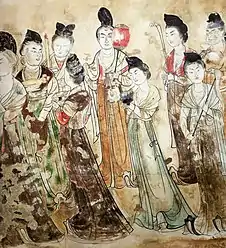 Tang dynasty court ladies from the tomb of Princess Yongtai in the Qianling Mausoleum, near Xi'an in Shaanxi
Tang dynasty court ladies from the tomb of Princess Yongtai in the Qianling Mausoleum, near Xi'an in Shaanxi Official Song dynasty portrait painting of Empress Cao, wife of Emperor Renzong of Song
Official Song dynasty portrait painting of Empress Cao, wife of Emperor Renzong of Song Modern reconstruction of temple mural shows clothes of the Yuan dynasty
Modern reconstruction of temple mural shows clothes of the Yuan dynasty Ming dynasty Empress Xiao'an
Ming dynasty Empress Xiao'an A 15th-century portrait of the Ming official Jiang Shunfu. The decoration of two cranes on his chest are a mandarin square "rank badge" that indicate he was a civil official of the first rank.
A 15th-century portrait of the Ming official Jiang Shunfu. The decoration of two cranes on his chest are a mandarin square "rank badge" that indicate he was a civil official of the first rank. Detail of Jiang Shunfu's rank badge
Detail of Jiang Shunfu's rank badge The Qing dynasty Qianlong Emperor in ceremonial armour on horseback
The Qing dynasty Qianlong Emperor in ceremonial armour on horseback Illustration of Chinese accessories from Olfert Dapper (1670): Gedenkwaerdig bedryf der Nederlandsche Oost-Indische maetschappye
Illustration of Chinese accessories from Olfert Dapper (1670): Gedenkwaerdig bedryf der Nederlandsche Oost-Indische maetschappye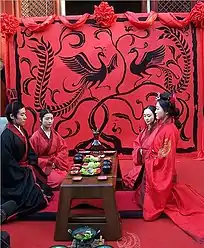 Zhou dynasty-style Chinese wedding dress
Zhou dynasty-style Chinese wedding dress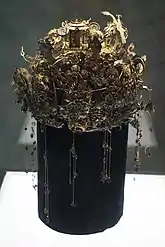 Chinese silver crown
Chinese silver crown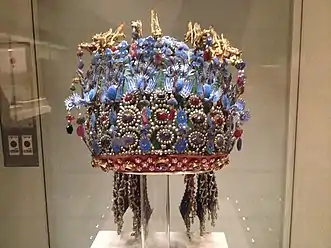 Fengguan of the Ming dynasty empress
Fengguan of the Ming dynasty empress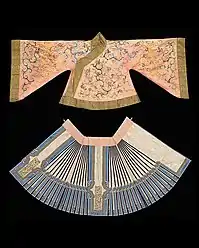 Hanfu of the Ming and Qing dynasties
Hanfu of the Ming and Qing dynasties Weimao in the Tang dynasty - Eighteen Songs of a Nomad Flute
Weimao in the Tang dynasty - Eighteen Songs of a Nomad Flute.jpg.webp) Tang dynasty woman wearing a cross-collared robe
Tang dynasty woman wearing a cross-collared robe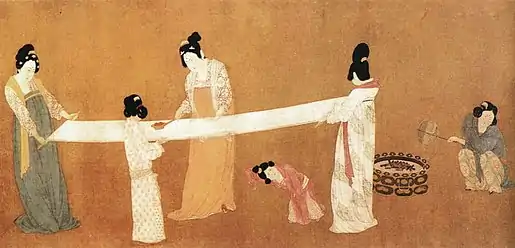 Hanfu in a famous Tang dynasty painting
Hanfu in a famous Tang dynasty painting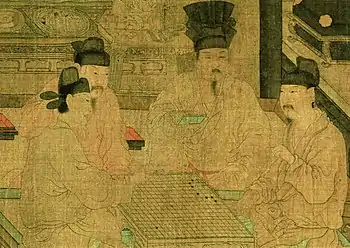 Ancient Chinese who played Go
Ancient Chinese who played Go Portrait of a Ming dynasty female official
Portrait of a Ming dynasty female official Gu Hongzhong's night revels
Gu Hongzhong's night revels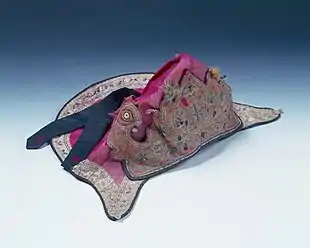 Traditional Chinese hat
Traditional Chinese hat Queen Mother of the West from a wall-painting in a Han dynasty tomb
Queen Mother of the West from a wall-painting in a Han dynasty tomb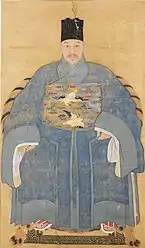 Official Ming dynasty portrait
Official Ming dynasty portrait_Nelson-Atkins_Museum_of_Art%252C_Kansas_City_(cropped).jpg.webp) Zhou Fang. Court Ladies Tuning the Lute (28x75) Nelson-Atkins Museum of Art, Kansas City (cropped)
Zhou Fang. Court Ladies Tuning the Lute (28x75) Nelson-Atkins Museum of Art, Kansas City (cropped)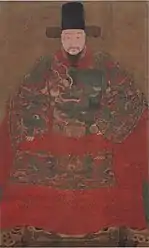 Official Ming dynasty portrait
Official Ming dynasty portrait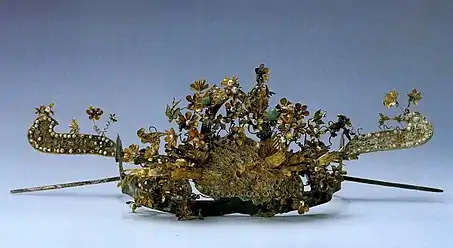 Cultural relics of female headdress during the Northern and Southern dynasties
Cultural relics of female headdress during the Northern and Southern dynasties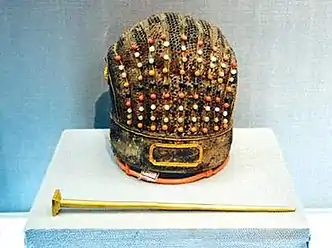 Hat relics of Ming dynasty officials
Hat relics of Ming dynasty officials Religion during the Ming dynasty
Religion during the Ming dynasty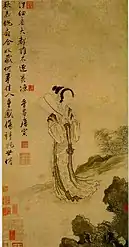 Famous Tang Bohu paintings
Famous Tang Bohu paintings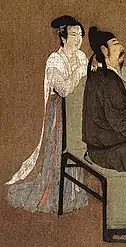 Hanfu during the Song dynasty
Hanfu during the Song dynasty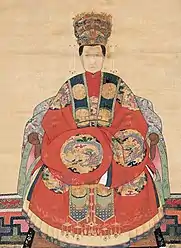 Portrait of a lady of the late Ming dynasty
Portrait of a lady of the late Ming dynasty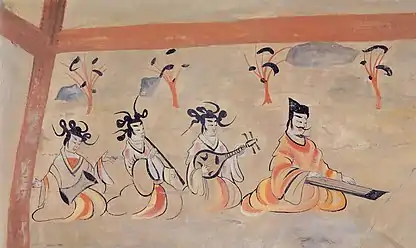 Image of musicians in ancient China
Image of musicians in ancient China Daily life records of court women during the Song dynasty
Daily life records of court women during the Song dynasty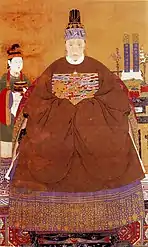 Portrait of a Ming noblewoman
Portrait of a Ming noblewoman Gu Hongzhong's Night Revels
Gu Hongzhong's Night Revels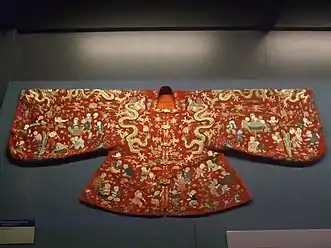 Clothing relics of the Ming dynasty
Clothing relics of the Ming dynasty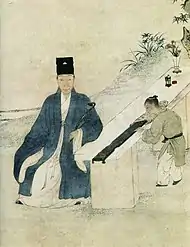 Portrait of Li Liufang
Portrait of Li Liufang Chinese bridal wedding gown
Chinese bridal wedding gown Traditional Chinese clothing
Traditional Chinese clothing
See also
References
- ↑ Yang, Shaorong (2004). Chinese Clothing: Costumes, Adornments and Culture (Arts of China). Long River Press (published April 1, 2004). p. 3. ISBN 978-1592650194.
- 1 2 Brown, John (2006). China, Japan, Korea: Culture and Customs. Createspace Independent Publishing (published September 7, 2006). p. 79. ISBN 978-1419648939.
- 1 2 Łukasz Sęk. "Chiński bucik królowej Marysieńki Sobieskiej" (in Polish). it.tarnow.pl. Retrieved 7 July 2014.
- ↑ Han and Manchus: Ethnic Relations and Political Power in Late Qing and Early Republican China, 1861–1928 by Edward Rhoads, p. 61
- 1 2 Law, Kam-yee. [2003] (2003). The Chinese Cultural Revolution Reconsidered: beyond purge and Holocaust. ISBN 0-333-73835-7
- ↑ Wen, Chihua. Madsen, Richard P. [1995] (1995). The Red Mirror: Children of China's Cultural Revolution. Westview Press. ISBN 0-8133-2488-2
- ↑ Broun, Samantha (6 April 2006). "Designing a global brand". CNN World. Archived from the original on 26 October 2012. Retrieved 2 June 2012.
- ↑ Chevalier, Michel (2012). Luxury Brand Management. Singapore: John Wiley & Sons. ISBN 978-1-118-17176-9.
- ↑ 1 Archived 2014-01-10 at the Wayback Machine.
- ↑ 1.
- ↑ "China's Hainan Airlines: Coolest cabin crew uniforms ever?". CNN World. 14 July 2017. Retrieved 14 July 2017.
- ↑ "G.O.D. and Kukri Design Collaborate for the Rugby Sevens". Hong Kong Tatler. 16 March 2012. Archived from the original on 15 August 2012. Retrieved 19 November 2012.
- ↑ "G.O.D. x Kukri". G.O.D. official website. Archived from the original on 15 May 2012. Retrieved 19 November 2012.
- ↑ "Kukri and G.O.D. collaborate on HK7s Range!". Kukri Sports. Archived from the original on 2 February 2014. Retrieved 19 November 2012.
- ↑ Bullock, Olivia (November 13, 2014). "Hanfu Movement Brings Back Traditional Fashion". The World of Chinese. Archived from the original on January 27, 2020. Retrieved July 30, 2016.
- ↑ Wee, Teo Cheng (November 20, 2015). "Stepping back in time at China's schools for traditional culture and Confucianism". The Straits Times. Retrieved July 30, 2016.
- ↑ Zhou, Dongxu (June 18, 2015). "China Prepares 'Traditional Culture' Textbooks for Its Officials". Retrieved July 30, 2016 – via Caixin.
Further reading
- Watt, James C.Y.; Wardwell, Anne E. (1997). When silk was gold: Central Asian and Chinese textiles. New York: The Metropolitan Museum of Art. ISBN 0870998250.
- Jian, Li; Li, He & Sung, Hou-Mei & Shengnan, Ma (2014). Forbidden City: Imperial Treasures from the Palace Museum, Beijing. Richmond, Virginia: Virginia Museum of Fine Arts. ISBN 978-1-934351-06-2.
{{cite book}}: CS1 maint: multiple names: authors list (link)